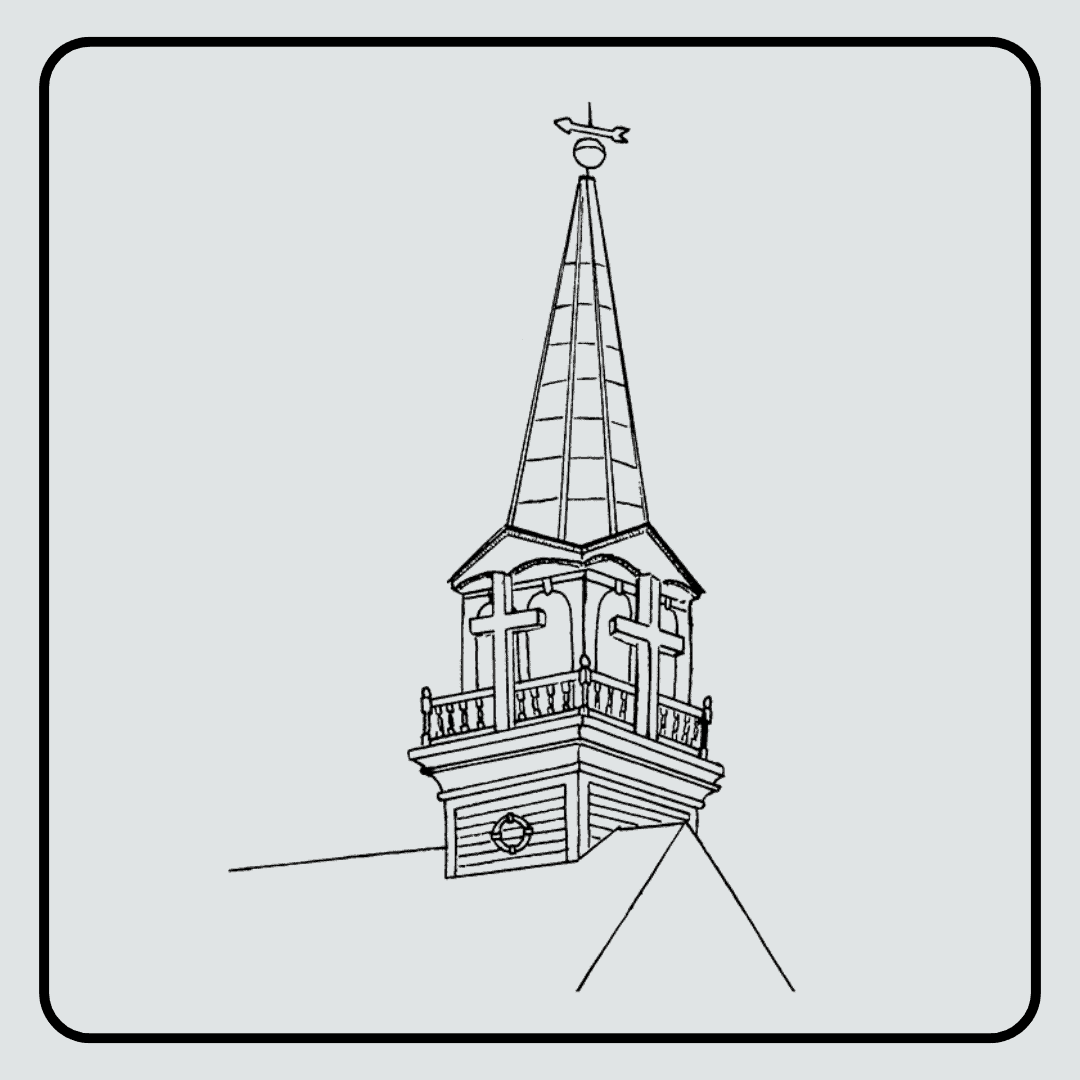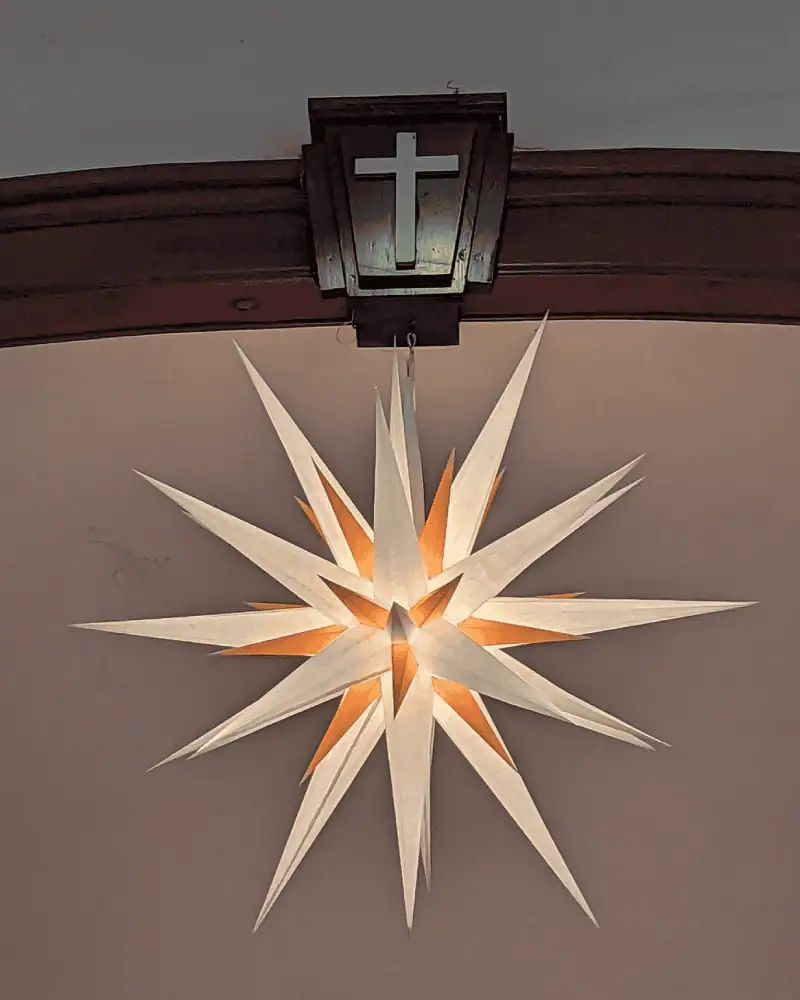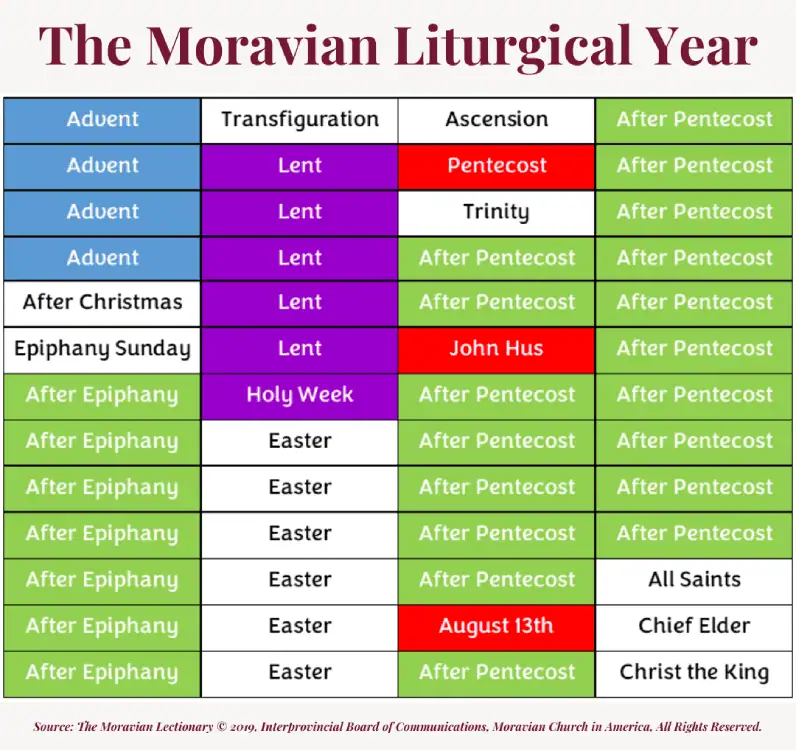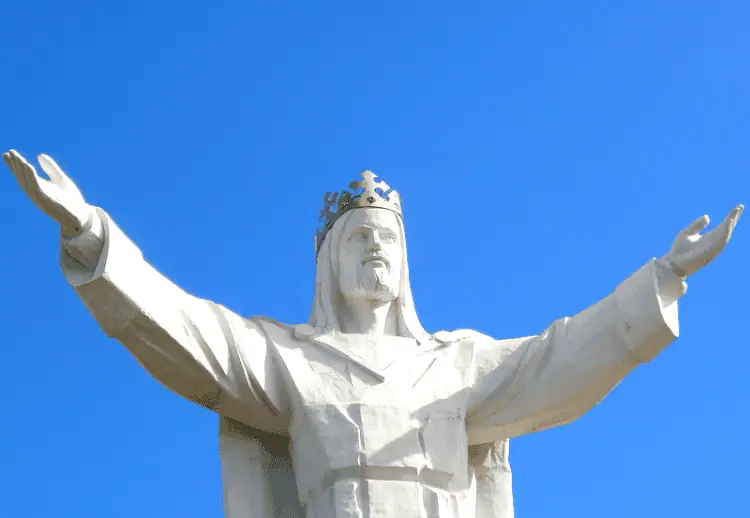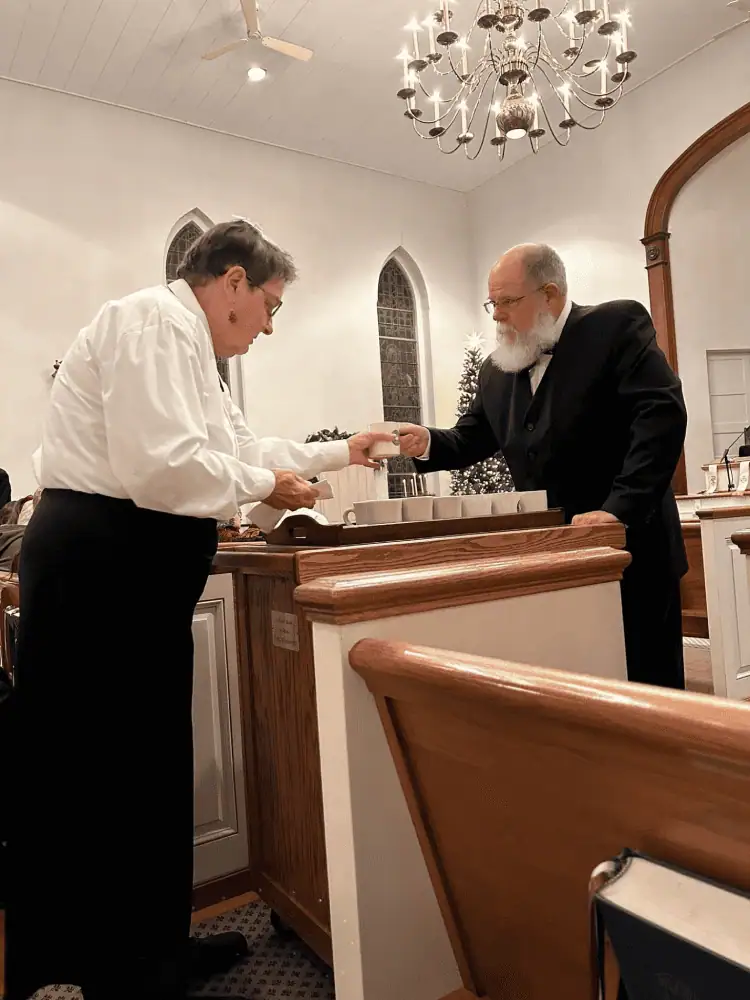Perhaps you know Moravians for the stars that shine from porches at Christmas. Or maybe you’ve enjoyed our sugar cakes and Ohio–baked chicken. Perhaps you’ve visited Historic Bethlehem, now a UNESCO World Heritage Site. Or you have raised a beeswax candle with red frills on Christmas Eve.
It’s easy to dismiss these customs as mere traditions that have been carried down through the years, as pretty decorations to be used at Christmastime, or novelties like eating in church. But each of them — from the lovefeast to the beloved “Hosanna!” anthem to the Singstunde to the Unity Prayer Watch — relates in some way to our relationship with Jesus Christ.
These customs and traditions remain special to Moravians because they continue to deepen and guide our faith, as individuals, as congregations, and as a world-wide church.
Special Worship Services
The Moravian Church provides a comprehensive litany for general worship and festive occasions. It is suggested that the Renewed Church, with its ties to German Lutheranism, is more liturgical than the Bohemian Brethren seemed to have been. The Moravians under Zinzendorf created a strong tradition of simplicity in worship, the kind that would naturally develop in homes and meeting places other than a church.
The heritage of the Moravians includes a liturgical form of worship which follows the tradition of the church year. Think of the annual remembrances that are common to all Christian churches — the birth of Jesus; the passion, death, and resurrection of Christ; Pentecost and Trinity Sunday; and congregational anniversaries.
But there are special commemorations unique to the Moravian Church which are spiritual landmarks in Moravian History. These include the way we worship during Holy Week, remembering the martyrdom of John Hus (July 6), the renewal of the Moravian Church (August 13), the acknowledgment of Jesus Christ as the Chief Elder of the Moravian Church (November 13), and a special dedication service known as the Cup of Covenant (September 16).
These Moravian festivals and worship customs have been celebrated for many generations.
Holy Week
Moravians have long had the practice of gathering for worship each evening of Holy Week to read the events of that day in Jesus’ life from the Scriptures. Our service book, Readings for Holy Week, represents a harmony account of the sufferings, death, resurrection, and ascension of our Lord Jesus Christ as it is found in the four Gospels of the New Testament. Moravians have shared a version of this moving collection for more than 250 years and we continue to use it each year.
For more information about how Schoeneck celebrates the season of Lent, Holy Week, and Easter, please click here.
The Martyrdom of John Hus
Schoeneck remembers and honors John Hus with a service of Holy Communion on the Sunday closest to July 6 each year. The service marks the occasion of the martyrdom of John Hus, whose teaching and preaching in the early 15th century gave rise to what is today the Moravian Church.
John Hus was a professor of philosophy and rector of the University in Prague who emphasized the importance of a personal relationship with God. Greatly influenced by the English reformer John Wycliffe, he advocated change in the Roman Catholic Church. Hus, who was an extremely good preacher, attracted large crowds and was not afraid to speak out about the reforms he felt were necessary.
Points of protest arising from the teachings of John Hus include:
- Worship services and the Bible should be in the language of the people.
- The communion cup should be offered to the laity, not reserved for priests alone.
- Christ alone should be recognized as Head of the Church.
- The authority of the Bible should take precedence over the authority of the Church.
- God’s grace was not for sale in the form of indulgences.
Hus was accused of heresy and excommunicated. Despite a promise of safe–conduct, he was arrested at the Council of Constance where he was imprisoned. When asked to recant his views, he refused. Hus was burned at the stake on July 6, 1415.
Martyrdom turned John Hus into a national hero; his followers banded together and called themselves the Hussites.
They were so convicted and convinced about the movement that God was making through them, that 42 years after John Hus was burned at the stake, the Moravian Church was born.
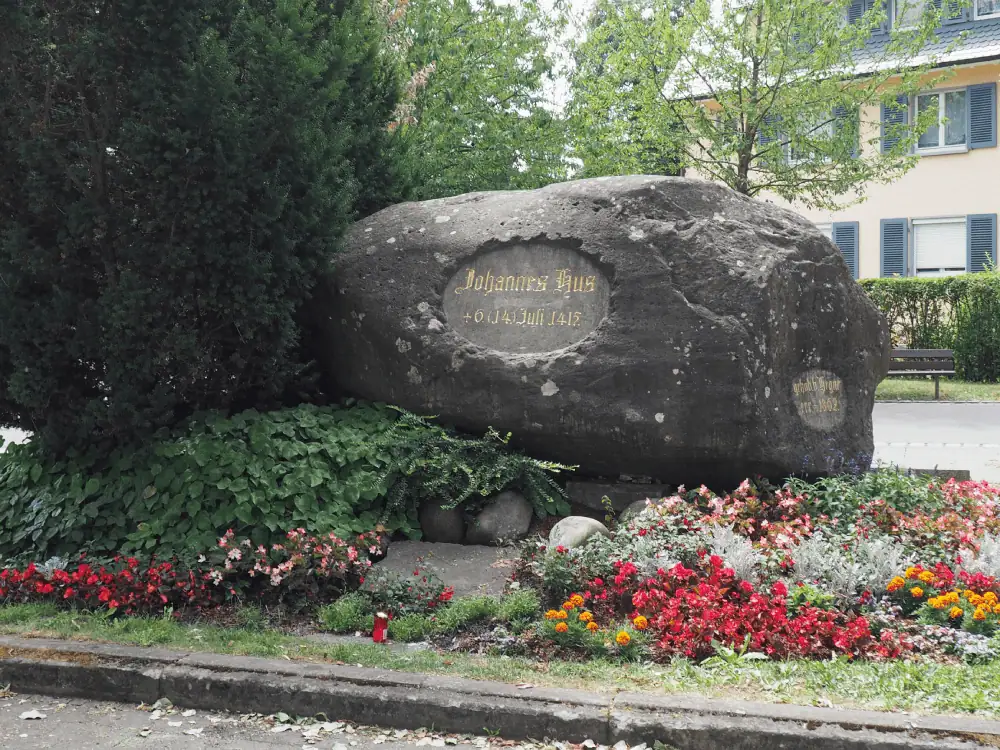
Moravians still proclaim John Hus as a martyr to the truth, a faithful witness of the gospel, and a shining example that truth cannot be disrupted by violence. His message still needs to be heard by all who care for the truth: “Seek the truth, listen to the truth, learn the truth, love the truth, speak the truth, abide by the truth, defend the truth unto death.”
The Renewal of the Moravian Church
In 1722 some families from Moravia, who had kept the traditions of the old Unitas Fratrum, fled from persecution in their homeland and found a place of refuge on the estate of Count Nikolaus Ludwig von Zinzendorf near Saxony in Germany.
A small village was built and its inhabitants hoped to live together as a community of awakened believers according to the example of the apostolic church. The village was named Herrnhut, which can be translated as ‘the Lord’s watch.’ This name is a play on words to express the faith that the people living there would be “on the watch for the Lord” and at the same time “under the Lord’s keeping.” Its inhabitants hoped to live together as a community of awakened believers according to the example of the apostolic church.
Under Zinzendorf’s protection, Herrnhut attracted more Moravian refugees as well as many believers and religious seekers from other places. As the community grew, differences among the inhabitants caused serious conflicts, leading to a severe crisis in 1726.
Zinzendorf, deeply grieved by the disunity, began visiting homes, praying with individuals, and teaching on the importance of Christian unity. He reminded the community of Jesus’ prayer in John 17:21 “That they may all be one. As you, Father, are in me and I am in you, may they also be in us, so that the world may believe that you have sent me.. Slowly, hearts softened, and the community began to repent of their pride and divisions.
On May 12, 1727, Zinzendorf introduced a communal covenant known as “The Brotherly Agreement” which outlined his vision of Herrnhut as a community based on Christian love. The community committed themselves to love one another, seek God, and live in unity. Under Zinzendorf’s care, they spent the summer of 1727 studying scripture and praying together in small groups, focused on the First Letter of John.
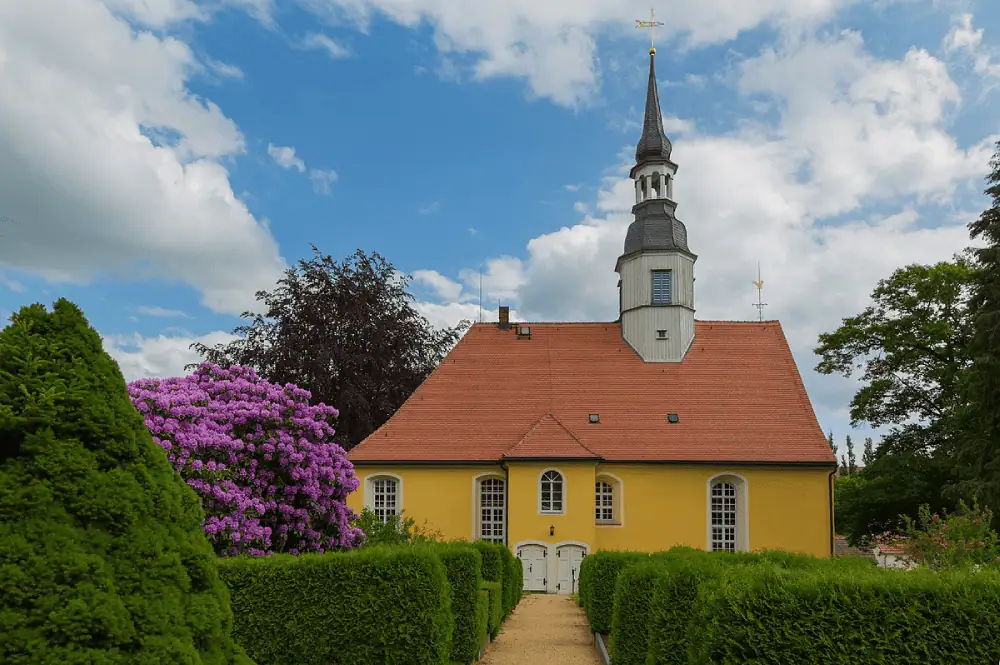
Then, on August 13, 1727, during a Holy Communion service at the Lutheran parish church in Berthelsdorf, the members of the Herrnhut community experienced a profound moment of spiritual renewal and reconciliation.
It was an outpouring of the Holy Spirit, which witnesses described as an overwhelming sense of God’s presence, leading to deep conviction of sin, fervent prayer, and an outpouring of love for one another.
This spiritual awakening transformed the community. They began gathering for prayer, worship, and Bible study with a renewed hunger for God. So great was the blessing felt during this communion, and so great and lasting was its influence, that it has been called both a Moravian Pentecost and the Birthday of the Renewed Moravian Church.
The unity that we celebrate each year on August 13, recalling the spiritual renewal that the brothers and sisters of Herrnhut experienced in 1727, is a gift of God to the Moravian community of faith. At Schoeneck, we commemorate the spiritual renewal of the Moravian Church with a celebration of Holy Communion — renewing our own covenant with Christ.
Jesus Christ As Chief Elder
Many church denominations have a person in charge of leadership for their church: either a Pope, a Presiding Bishop, a Patriarch, an Archbishop, or a President, among others. The Moravian Church has had no single human chief executive since November 13, 1741 when an announcement was made in all Moravian congregations that Jesus Christ had been chosen Chief Elder of the Moravian Church. As Chief Elder, Jesus governs and guides our lives on earth, including our relationships within the church.
But how did this come to be? On September 16, 1741, the leaders of the Moravian Church were meeting in London for a Synodal Conference to make a number of important decisions, one of which was to choose a new Chief Elder. The Chief Elder was responsible for the spiritual and temporal welfare of the whole Moravian Church.
When the church was a community in Herrnhut, Germany, it was a manageable job. But the Moravian Church had grown into an international fellowship stretching from Greenland in the north to South Africa in the south. It would soon stretch to America in the west. At the time of the meeting Leonard Dober had been serving as Chief Elder for several years. Brother Dober was getting older, and the job was beginning to wear on him. At the London meeting, he officially asked to lay down this office.
The Lot
In those days, to determine the will of the Lord in any situation in which the right course of action was not clear, major decisions were decided by casting Lots — a draw of chance to leave the decision up to God, who was held as infallible. The lot was not viewed as merely the “luck of the draw,” but as a way they could essentially speak with God in order to make the best decisions for the community.
Scripture verses were written on three pieces of paper to signify either “Yes”, “No”, or “Wait” (an answer that essentially left the matter up to further consideration or discussion). Depending on the question that was brought to the lot, sometimes only affirmative and negative lots were used. The pieces of paper were placed into a container, and the leaders prayed for guidance before reaching into the container to retrieve God’s answer. In this way, the Moravians allowed their devotion to Christ and their faith to guide them.
At the conference in London, the Elders, made up almost equally of men and women, asked the lot if Leonard Dober could step down from the position of Chief Elder. The answer was “Yes.” They then submitted a series of names of people they thought were able to replace him. But each time they submitted a name, the lot said “No.”
The Elders grew worried, and they took the time to pray and read the Bible. All of the scriptures they read talked about the role that Jesus played as the Great Shepherd and Lord of the church. Who better was there to take on that role than he who had omnipotent qualities and was already universally accepted by the church?
After some discussion, the elders decided to ask whether Jesus himself would undertake the office of Chief Elder. To their surprise, the lot said, “Yes.” Then, in good Moravian fashion, they sang a hymn of praise.
Spreading The Word
Afterward, they all agreed that what had taken place among them was so important that it should be announced to the whole Moravian Unity on a single day. They set the date of November 13, 1741 for the announcement and the rest is history.
On the Sunday closest to November 13 each year, the Moravian Church affirms Jesus Christ as our Head and Chief Elder. With Jesus as Chief Elder, we are demonstrating our motive, our passion, and our love of God and the ministries God has entrusted to us.
We also acknowledge that no human intervention, even with our varied gifts and skill sets, can adequately do the work of Chief Elder. We remain grateful for our predecessors, who defied convention and appointed the head of our lives as the head of the church.
Schoeneck Moravian Church affirms Jesus Christ as our Chief Elder with a service of Holy Communion on the Sunday closest to November 13 each year.
The Cup of Covenant
According to Customs and Practices of the Moravian Church by Adelaide Fries, The Cup of Covenant, or Cup of Thanksgiving, was used for the first time in Herrnhut in 1728 to “prepare the heart for the communion which could not be held just then.” In the early years of the Renewed Moravian Church, the cup was used frequently “to give thanks for special manifestations of grace and to covenant together for new faithfulness in the service of Jesus.”
The General Synod of 1775 adopted the Cup of Covenant as a formal institution. While the Cup of Covenant somewhat resembles communion, it should not be confused with the Sacrament. Instead, the Cup is considered an expression of unity and dedication, as well as a commitment to continue to work in Christ’s service.
For more than 200 years, September 16th has been observed as a Covenanting Day for Moravian church leaders around the world. Moravian pastors, both current and retired, gather to share the Cup of Covenant in simple services and activities to recommit themselves to their work, to each other, and to the Moravian Church.
Many Moravian churches celebrate a Cup of Covenant when new board members are elected each year, at the beginning of a new Christian Education year, or for the launch of a capital campaign. The Cup of Covenant can be used for any occasion where the focus is an expression of unity and rededication of purpose in serving God.
The Singstunde
Moravians have long been renowned for their love of congregational singing and their practice of letting hymns and liturgies reveal their theology. It is said that Count Nicholas Ludwig von Zinzendorf was a prolific hymn writer and composer. Legend has it that Zinzendorf composed a hymn of 67 stanzas in one evening! It’s easy to conclude that Zinzendorf impacted the community in such a way that they all grew to love singing in worship.
It is said that when one sings, they pray twice. It’s clear to see why the Moravians placed so much emphasis on singing. Singing of hymns offered many opportunities for active participation by the congregation in worship. Zinzendorf actively cultivated within the Herrnhut congregation an appreciation of the spiritual power of hymnody and gradually developed this unique kind of service called the Singstunde. This became the favorite form of public worship for Zinzendorf and the community at Herrnhut.
This heritage is carried on in the modern Singstunde. Literally translated from German as ‘hour of singing,’ the Singstunde is a service where the congregation sings a series of hymns or stanzas of hymns that have been chosen carefully by the minister and put together to convey a specific devotional theme.
Most Moravians in the 18th and early 19th century had several hundred hymn stanzas committed to memory. This made holding a Singstunde simple. The pastor would select stanzas from many different hymns and place them in order. During the Singstunde, the pastor would simply begin singing a stanza, and the congregation joined in by memory. Upon conclusion of that verse, the pastor began another. The theme of the service was thus revealed to the congregation through the selected texts.
Holding a Singstunde today is a bit different. The specific hymn stanzas are printed in a bulletin and often just one or two stanzas of a hymn are used. Hymns may also be interspersed with Scripture readings and choir anthems. The purpose remains the same — the revelation of a devotional theme through carefully chosen hymns sung by the entire congregation. In essence the music becomes the sermon. The message was powerfully proclaimed through the Singstunde. Each person becomes part of the message, the messenger, and the recipient.
The musical structure of two beloved Moravian services are outgrowths of the Singstunde — our lovefeasts and our way of celebrating Holy Communion. For both, the purpose remains the same: a devotional theme or concept with carefully chosen and ordered hymn verses which are sung by the entire assembly.
Moravian Lovefeasts
A Lovefeast is a Singstunde which incorporates a simple meal. Lovefeasts originated in the first gatherings of Christians after Pentecost. The early Christians met and broke bread together in an expression of their fellowship and love.
The Moravian Church has made it our custom to celebrate special occasions by sharing a simple meal during worship — a “lovefeast.” A Lovefeast is not a sacrament like Holy Communion but seeks to remove social barriers and strengthen the spirit of unity and goodwill among all people.
The first Moravian Lovefeast was served in Germany on August 13th, 1727, following the Renewal of the Moravian Church. The actual food and drink may vary considerably — in Germany, you may eat raisin rolls, in the Caribbean you may drink tea, in Africa you may eat peanuts. At Schoeneck, we serve Moravian sugarcake with chocolate milk or lightened coffee.
Those who serve the meal are called Dieners, which is German for “server.” The manner of serving may also vary — except that all wait until everyone has been served and the Pastor has asked the Blessing. Some congregations listen to the choir sign hymns and anthems while they enjoy the Lovefeast meal. In other congregations, people speak quietly with their neighbors about their spiritual journey.
The Lovefeast is a simple meal shared in a spirit of reverence and joy that Christ is present in our lives. It has held great significance for Moravians for over two and a half centuries.
For more information on Moravian Lovefeasts, including the lovefeasts celebrated here at Schoeneck, please click here.
The Hosanna Anthem
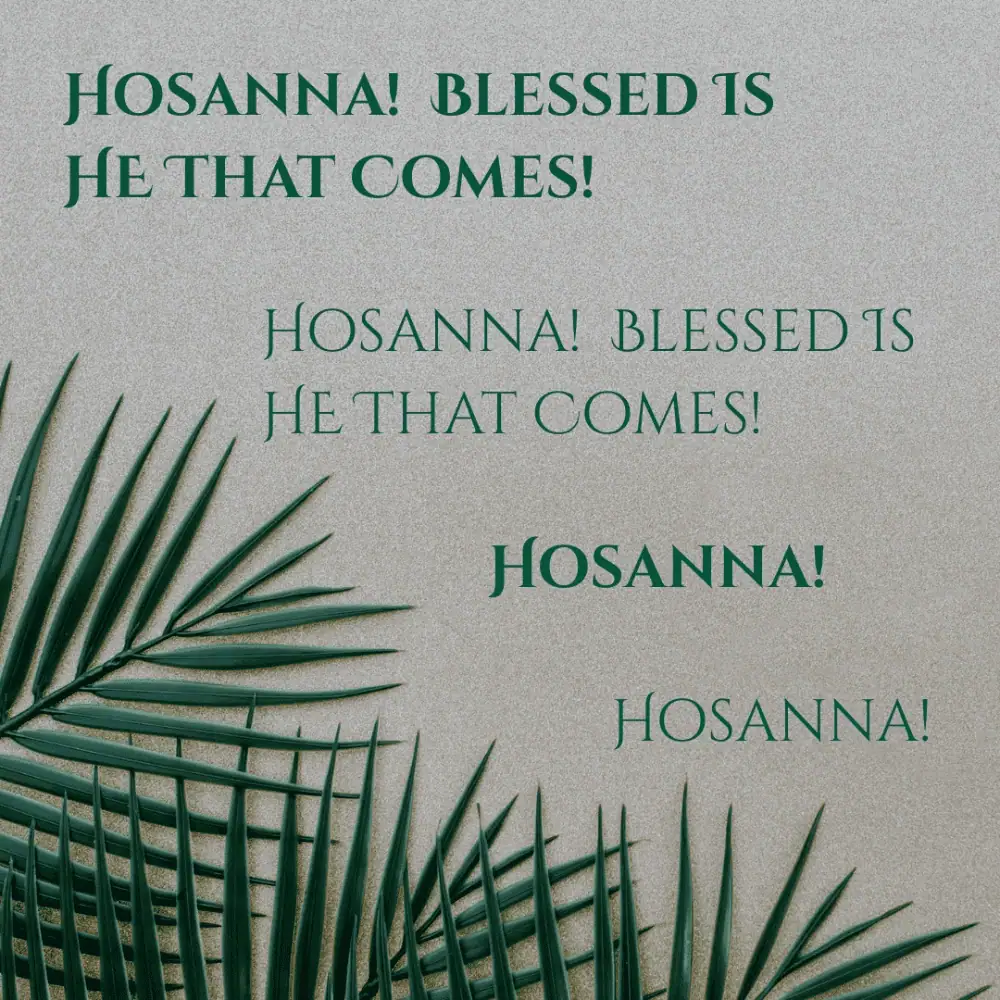
One of the most beloved traditions in the Moravian Church is the singing of the “Hosanna” anthem. The “Hosanna” anthem was written by Bishop Christian Gregor of Herrnhut in 1765, and is sung on the first Sunday of Advent and Palm Sunday. It is antiphonal, with one part echoing the other.
Traditionally it was sung between the men and women in the congregation, where the men would call and the women would respond. For example, the men would call: “Hosanna, blessed is He that comes” and the women would respond: “Hosanna, blessed is He that comes.”
Today, it is often sung between choir and congregation, between the children and adult congregation, or played between trombone choirs.
The “Hosanna” anthem was inspired by the text from Matthew 21:8–9 — “A very large crowd spread cloaks on the road, while others cut branches from the trees and spread them on the road. The crowd that went ahead of him and those that followed shouted, Hosanna to the Son of David! Blessed is he who comes in the name of the Lord! Hosanna in the highest!”
The word hosanna means “save us.” So when Jesus rode into Jerusalem the people were shouting “Hosanna!” to Jesus, or in other words, “Jesus, save us!” That is why the song is sung for Advent and for Palm Sunday. Both occasions refer to the coming of Christ. In Advent we look forward to Jesus being born into the world to save us from our sins. On Palm Sunday Jesus is the Messiah who comes to deliver Israel.
For a lot of Moravians, it is not Advent or Palm Sunday without the singing of “Hosanna!”
The Lebenslauf
Moravians have traditionally kept meticulous records — of the weather, of meetings, of large and small events in the life of a community or congregation. In a similar way, each member of the church was encouraged to write a brief spiritual memoir in midlife. Important life events were recounted with special attention given to spiritual struggles and progress.
When that person passed away, the pastor finished their memoir and read it at the person’s funeral as a testimony of the life and faith of the deceased person. Moravians call this document a Lebenslauf, a German word comprised of leben for life and lauf for path. So Lebenslauf literally means “life path.”
The tradition started in Herrnhut with Count Zinzendorf in the 1750s as a means to bid farewell to a member of the church community. Count Zinzendorf saw the Lebenslauf as a way to turn our hearts outward, to offer a legacy to family and community, and to make the “invisible church visible.”
Contained within the Lebenslauf are realizations that people can have a direct impact on — and the ability to change — their world, their community, and their church. In this way, a Lebenslauf is meant to be an encouraging example to those who are left behind. Many of these Lebenslauf can be found in the various archives of the worldwide Moravian Unity.
This practice of writing a spiritual memoir has continued in many Moravian congregations to the present day. A modern Lebenslauf is a record of a person’s journey of faith where they have experienced God working in their life. It also gives us an opportunity to communicate to family and friends about the events and people who have shaped our lives in our faith journey.
Writing a Lebenslauf allows us a prayerful “walk” with God and creates an awareness of God’s presence in our lives. You do not need to consider yourself a writer to compose a Lebenslauf — in fact you may find reflecting on how God has worked in your life to be a thoughtful spiritual practice.
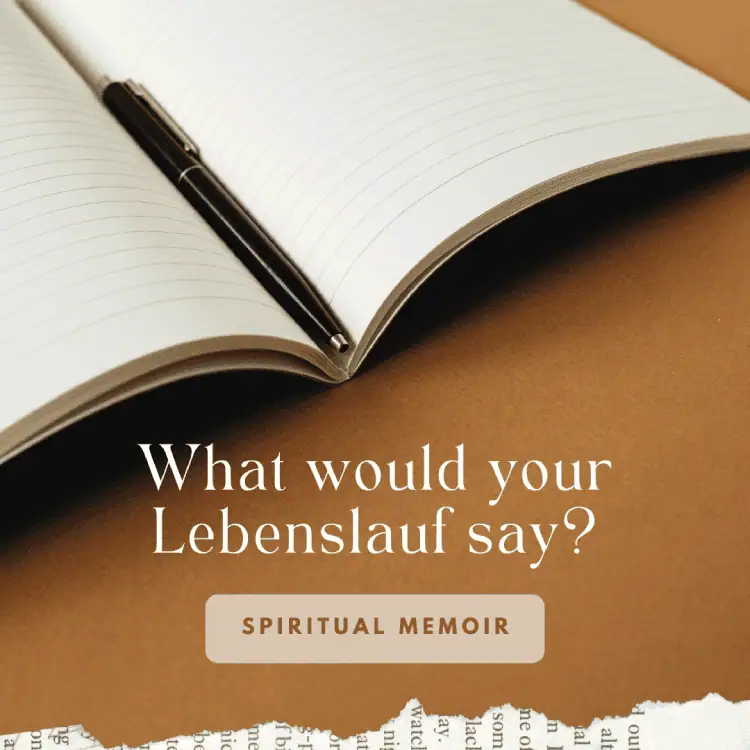
The Unity Prayer Watch
The people of the Moravian Church are constantly praying — literally. Moravian congregations around the world take turns carrying the responsibility of having at least one member in prayer at all times, 24 hours a day, 365 days a year. It’s a wonderful opportunity to be one link in an endless chain of prayer!
The Unity Prayer Watch started within the Moravian community in Herrnhut in 1726. The congregation sought guidance from God for their shared life as disciples of Jesus, and how to follow where Jesus led them. The community was in prayer each hour of the day, as different groups prayed and listened for God’s direction. This commitment to prayer is recognized as a spark of God’s Spirit that led to the Renewal of the Moravian Church on August 13, 1727.
In the days following this awakening, a group of men and women decided to continue this “holy watch over the congregation.” Brothers and sisters signed up so that each one could take one hour of the day or night to pray in his or her room. This prayer watch was known as the “hourly intercession.” For the Moravians, prayer was not just a duty but a way of life, fueling their relationship with God and their passion for the lost.
Prayer of that kind always leads to action. In this case it kindled a burning desire to make Christ’s Salvation known to the world. It led to the beginning of Moravian Missions. The Hourly Intercession continued within every Moravian congregation for roughly 100 years, even as the Church grew and spread worldwide. The hourly intercession was exercised in many Moravian congregations until 1825.
In 1957, when the Unitas Fratrum celebrated its 500th anniversary, the women’s group of Herrnhut proposed a revival of the hourly intercession for the entire worldwide Church as part of the anniversary year. At Unity Synod that year it was unanimously agreed to reestablish the Unity Prayer Watch on an ongoing basis throughout the entire Church. The Unity Synod of 2009 reaffirmed this covenant.
Joining together with our world-wide Moravian family, we are able to be in conversation with God not only every day of the year, but literally every hour and minute. The church has gained a great deal of strength in good times and in times of difficulty through prayer. As we continue in this sacred tradition, we must acknowledge that it is actually a gift we give not only to the world, but an honor given to our Chief Elder, Jesus Christ.
Schoeneck Moravian Church is usually assigned a day in December to take part in the Unity Prayer Watch. Information can be found in our bulletins, newsletter and social media pages as the date approaches. For 2025 Unity Prayer Watch Topics, please click here.
Moravian Birthday Hymn
The “Moravian Birthday Hymn” is one of a genre of hymns known by Moravians as Segensverse (blessing hymns). It is used as a prayer of blessing for a birthday, and also at times of parting and farewell. We often sing it at the end of a retreat or conference, as a prayer for the retreat leader.
The hymn is deeply moving to those for whom it is sung — especially those new to Moravian tradition, who haven’t experienced this before. Honoring birthdays with these words instead of the familiar “Happy birthday to you” song conveys thoughtful prayer as well as happy good wishes, and brings deep blessing to the recipient.
The hymn can be easily adapted for many occasions by changing the pronouns that are in parentheses in the text below.
With Your Presence, Lord
With your presence, Lord, our Head and Savior,
bless (us all now or person's name), we humbly pray;
our dear heavenly Father's love and favor
be (our or he/she/their) comfort every day.
May God's Spirit now in each proceeding
favor (us or him/her/them) with His most gracious leading;
thus shall (we or he/she/they) be truly blessed
both in labor and in rest.
Some information on this page has been taken from the Moravian Church In America website. Copyright © 2010-2025, Interprovincial Board of Communications, Moravian Church in America. All Rights Reserved.
Some information on this page has been taken from the Moravian Music Foundation website. Copyright © 2025, The Signal Company. All Rights Reserved.
Some information in the Singstunde section of this page is from “Moravian Moment #137 — Singstunde: A Moravian Song Service” written by Rev. Dr. Cortroy Jarvis, October 18, 2009. Copyright © 2025 The Moravian Church – Eastern West Indies Province. All Rights Reserved.
Some information in the Jan Hus Holy Communion section of this page is from “Moravian Moment #25 — John Hus- Reformer and Martyr” written by Rev. Dr. Cortroy Jarvis, July 1, 2007. Copyright © 2025 The Moravian Church – Eastern West Indies Province. All Rights Reserved.
Some information in the Hosanna Anthem section of this page is from “Moravian Moment #176 — An insight In Moravian Heritage” written by Rev. Dr. Cortroy Jarvis, July 25, 2010. Copyright © 2025 The Moravian Church – Eastern West Indies Province. All Rights Reserved.
“The Moravian Birthday Hymn” information is from the article “Notes from Nola… The Moravian Birthday (Blessing) Hymn”, written by Rev. Dr. Nola Reed Knouse. Used with Permission. Copyright © 2025, The Signal Company. All Rights Reserved.
The hymn “With Your Presence, Lord” is from the Moravian Book of Worship, Hymn #447. Text: Christian Gregor (1767). Tr. and alt. John Swertner (1789), alt. Tune: Covenant (185 A). Copyright © 1995, Interprovincial Board of Communications, Moravian Church in America. All Rights Reserved.
Photo Credit: The monument in Konstanz, where reformer Jan Hus was executed (dedicated 1862). Photo by Harke, CC BY-SA 3.0, via Wikimedia Commons. All rights reserved.
Photo Credit: Lutheran Church (Evangelisch-Lutherische Kirche) of Berthelsdorf, district of Herrnhut, Landkreis Görlitz, Saxony, Germany. Photo by J.-H. Janßen, CC BY-SA 4.0, via Wikimedia Commons. All rights reserved.
Photo Credit: Pomnik Chrystusa Króla (Monument of Christ the King) is a statue of Jesus Christ in Świebodzin, western Poland. Photo by Aw58, CC BY-SA 3.0, via Wikimedia Commons. All rights reserved.
